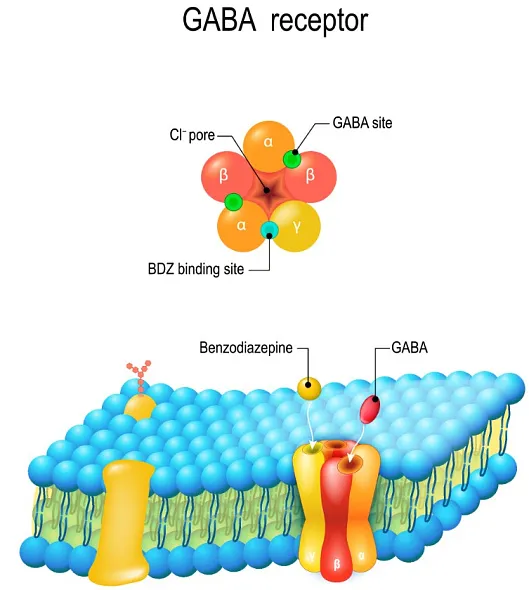GABA Library
ChemDiv’s library of small molecules targeting GABA receptors contains 7,123 compounds.
Gamma-Aminobutyric acid (GABA) functions as the primary inhibitory neurotransmitter in the central nervous system. Due to its highly flexible structure, GABA can adopt numerous low-energy conformations. Three major types of GABA receptors have been identified: GABA-a, GABA-b, and GABA-c receptors. GABA-a and GABA-c receptors belong to a superfamily of transmitter-gated ion channels, which also includes nicotinic acetylcholine receptors, strychnine-sensitive glycine receptors, and 5-HT3 serotonin receptors. GABA-a receptors are hetero-oligomeric chloride channels that are selectively inhibited by the alkaloid bicuculline and modulated by compounds such as steroids, barbiturates, and benzodiazepines [1].
GABA receptors play a critical role in drug discovery due to their central function in modulating neuronal excitability and synaptic transmission in the brain. As the main inhibitory neurotransmitter receptors in the central nervous system, they are key targets in developing treatments for a variety of neurological and psychiatric disorders, including anxiety, epilepsy, insomnia, and muscle spasms. Drugs that enhance GABA receptor activity, like benzodiazepines and barbiturates, are effective sedatives and anticonvulsants, while antagonists of these receptors can have stimulant or convulsant properties and are useful in specific clinical situations, such as counteracting sedative overdoses. The versatility of these receptors as drug targets, combined with the diversity of their subunits and pharmacology, provides a rich landscape for the development of new therapeutics that can modulate GABAergic signaling in more specific and potentially safer ways, addressing a broad spectrum of CNS-related pathologies.
Currently, there are a wide variety of GABA-a receptor antagonists available. GABA receptor antagonists are drugs that inhibit GABA's action. Generally, those drugs produce stimulant and convulsant effects and are primarily used to counteract overdoses of sedative drugs. Examples of these antagonists include bicuculline, securinine, and pentylenetetrazol.
The GABA-targeted small molecule library is a crucial resource in drug discovery, offering a vast array of compounds specifically designed to modulate the GABAergic system. By providing targeted molecules that can either potentiate or inhibit GABA receptors, this library plays a vital role in the development of new treatments for a wide range of neurological and psychiatric disorders, from anxiety and epilepsy to sleep disturbances and muscle disorders. The diversity and specificity of the compounds in this library not only accelerate the drug development process but also open avenues for more precise and effective therapeutics with potentially reduced side effects.
References
[1] M. Chebib and G. A. R. Johnston, “The ‘ABC’ of GABA receptors: A brief review,” Clin. Exp. Pharmacol. Physiol., vol. 26, no. 11, pp. 937–940, 1999, doi: 10.1046/j.1440-1681.1999.03151.x.
